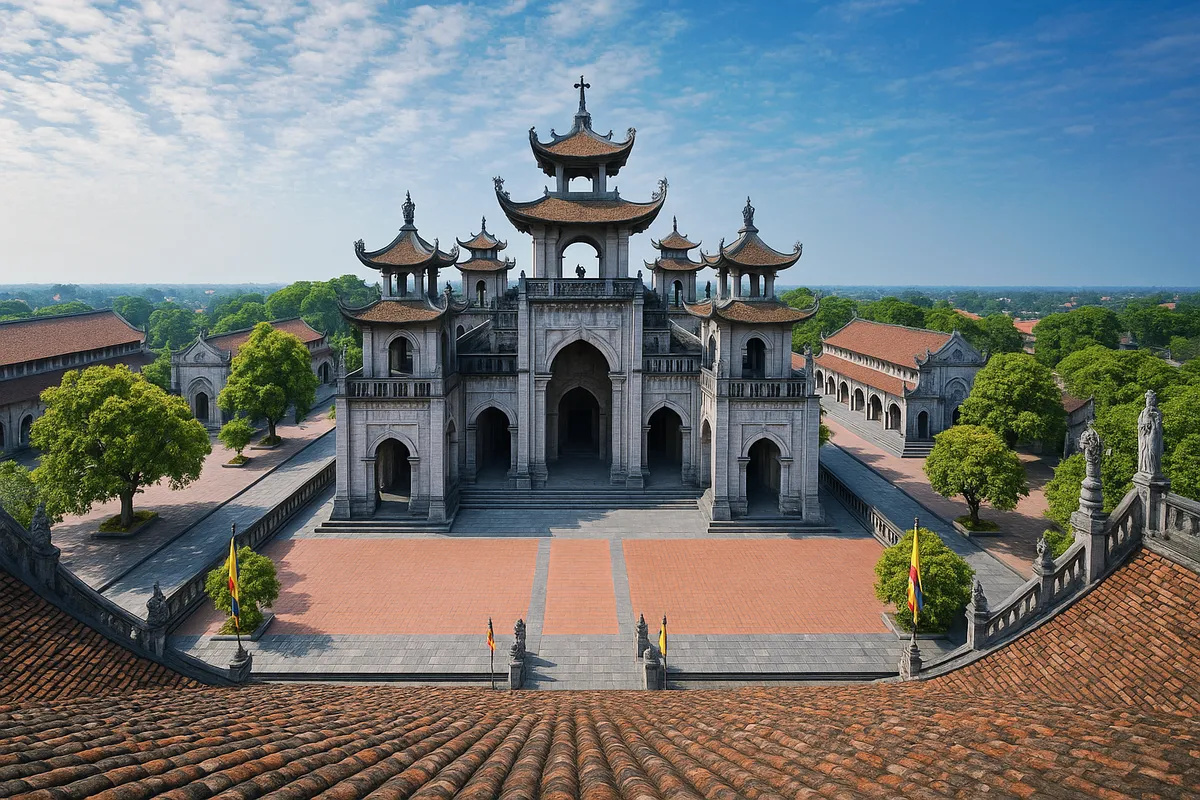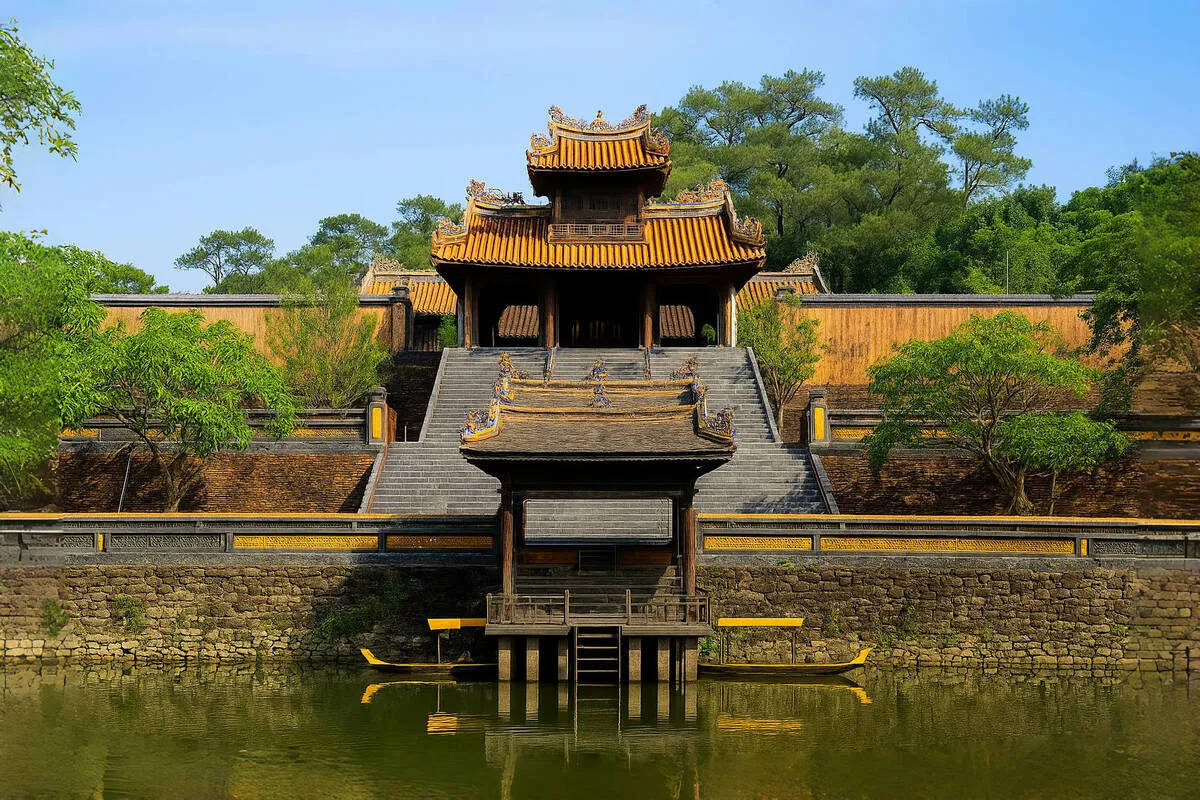Phat Diem Stone Church, a masterpiece in the North
- Saturday, May 10, 2025, 20:24 (GMT+7)
Phat Diem Stone Church, a masterpiece in the North
Phat Diem Stone Cathedral is where time does not pass but settles into every grain, every ripple on stone, every curved tile roof arching like a dragon’s spine reclining in the northern delta. Amid winding village paths lined with betel palms and leaf-shedding trees, it appears like a daytime mirage, solemn yet majestic, ancient yet breathing with modern soul. Its beauty needs no promotional words, for simply standing still and looking is enough to quiet the heart.
Located in Phat Diem town, Kim Son district, Ninh Binh province, the Phat Diem Cathedral complex spans over 22 hectares. It is not only a place of worship for Catholic believers but also an architectural masterpiece bearing the soul of Vietnamese culture. Viewed from above, the complex resembles an ancient Eastern temple with lakes, a three-entrance gate, bell tower, and gracefully curving temple roofs. Yet stepping inside feels like entering an old European basilica, with its stone arches, stone columns, and solemn crosses.
What sets this place apart is not just the fusion of Eastern and Western architecture, but the way each stone, each wooden beam here tells a story. Built over 24 years from 1875 to 1898 by Father Peter Tran Luc, known as Cu Sau, a man without formal architectural training but with the eye and heart of a genius artisan, the cathedral has become a symbol of harmony where Catholic faith and Eastern aesthetics meet without overshadowing one another.
Phuong Dinh is the heart of the entire complex. A 25 meter high square bell tower, divided into three tiers, stands like a time box. At its summit hangs a bell weighing over two tons, whose resonant sound echoes far across the fields like a sacred call awakening the world from worldly ignorance. Here, intricate stone bas-reliefs depict Saints, dragons, phoenixes, pine trees, chrysanthemums, bamboo, and apricots, motifs reminiscent of northern Vietnamese temples, making one feel as if standing at the intersection of two cultures, two beliefs, two worlds.
Not far away is the Heart of Mary Chapel, often referred to as the Stone Church, built entirely from monolithic blue stone. In the afternoon sun, its stone walls resemble a dried lakebed cracked by memory, yet inside lies a tender and warm space, where light filters through curved roof slats into golden streaks like Rosary beads gently scattered across the soul. Carved on the walls are motifs of the four seasons, the four elegant plants, lotus flowers, and chrysanthemums, symbols of deep reverence for nature and the cycle of human life.
A few steps further, where aged barringtonia trees bloom crimson beside the crescent lake, lie manmade grottos recreating Bethlehem and many biblical stories. Few know that these grottos were entirely handcrafted without cement, bonded instead using traditional mortar made from tree resin, lime, and sugarcane molasses, which has endured more than a century of rain and sun.
The story of Father Tran Luc building the cathedral is filled with marvels. It is said that he sailed dozens of kilometers to the mountains of Thanh Hoa to personally select stones, each weighing several tons, floated down the Hoang Long River on rafts to Kim Son. Without blueprints, he drew plans by hand and guided local carpenters and stonemasons through the construction. That is why the architecture here is not rigid but soft and full of emotion, as if built more by prayer than by human hands.
In today's rhythm of life, visitors coming to the stone cathedral on a spring morning might encounter locals wearing traditional brown robes and conical hats, carrying white lily bouquets, the scent of incense mingling in the air, church bells ringing through early mist like a spiritual call to return to one’s roots. It is also common to see groups of young people choosing this place for check-ins, wedding shoots, or simply sitting quietly along stone corridors to write in a personal diary. Few know that this place once served as the set for a French historical film, thanks to its uniquely ancient and timeless atmosphere.
The best time to visit Phat Diem is from November to April when the weather is dry, the light is gentle, and trees in the complex begin to shed their leaves. For those seeking magical splendor, Christmas is a moment not to be missed. During this time, the entire cathedral glows with thousands of lights, nativity scenes, angel statues, and brilliant Christmas trees, creating a fairy tale setting.
Reaching Phat Diem is quite convenient. From the center of Hanoi, it takes only about three hours by car. National Route 1A and then a turn onto Route 10 will take travelers through rice fields and peaceful villages, where white storks silently glide across the harvest season. You may also take a train to Ninh Binh, then rent a motorbike or taxi to continue the journey to Kim Son, where travel maps still leave blank spaces for unnamed skies.
When visiting, do not rush away without trying a bowl of Kim Son pork ball noodle soup, a seemingly simple dish with a distinctly sweet broth made from simmered bones, and hand-rolled pork balls seasoned just right. The cuisine around the cathedral is humble, yet enough to make a passerby nostalgic, a fragrant grilled meat skewer, a warm glass of soy milk in the chilly air, or just a cup of lotus tea at an old shop with a radio whispering in the wind.
There are places that need no crowds, no noise, no blue seas or high mountains, yet they linger in the heart. Phat Diem Stone Cathedral is one of those places. Like a doorway into the cultural depth of Vietnam, where each stone carries the breath of the earth, each curved roof whispers of ancestors, and each bell toll calls memories from afar.
“Some places are born to be kept in the heart, not rushed through.” That is what people often say as they leave the cathedral gates, glancing back at the moss-covered roof resting quietly in the golden light. And in that glance, perhaps, a part of the soul has stayed behind, with the stones, with the wind, in a land of memory called Phat Diem.

 CHECKIN.VN
CHECKIN.VN








Share on